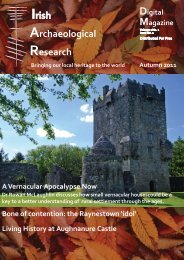Irish Archaeological Research Digital Magazine
Irish Archaeological Research Digital Magazine
Irish Archaeological Research Digital Magazine
Create successful ePaper yourself
Turn your PDF publications into a flip-book with our unique Google optimized e-Paper software.
Figure 3: Bodley map<br />
Bartlett was a lieutenant serving under Lord Mountjoy, who had distinguished himself as a capable<br />
cartographer – a rare thing indeed. Bartlett provides a measure of the situation at the time; a<br />
talented cartographer who was discovered among the soldiery and put to work. No cartographers<br />
of the day were volunteering to confront the difficult working conditions of Ireland, and many reports<br />
agree on the general shortage of competent map-makers at the time. The fact that this shortage<br />
was due in part to the hostility of the land is reinforced by the manner in which Bartlett met his end,<br />
when, on a survey of Donegal, he was beheaded by the locals in an act of defiance to the new<br />
king.<br />
Sir Josias Bodley led the survey of Ulster for James I; Bodley was a military engineer who had<br />
served in the war against the O’Neill. He produced a collection of maps c.1609, intended to be a<br />
more accurate and comprehensive survey of the escheated counties than anything that had gone<br />
before, thus delivering to the king the true value of lands forfeited to the crown by the rebellious<br />
natives. The surviving maps cover counties Fermanagh, Tyrone, Armagh and Cavan, with parts of<br />
Londonderry and Louth. Previous surveys had underestimated the acreage of these lands by up to<br />
two-thirds, so Bodley must have won the king’s favour when he delivered his results.<br />
The Bodley maps were produced by a team of six ‘surveyors’, who, rather than doing any physical<br />
topographical survey, conducted a guided walk-over of all the forfeited lands and produced written<br />
descriptions of all the necessary information. As his guides were local people, many of the place<br />
names recorded were in Gaelic form and in some areas cannot be easily identified with modern<br />
equivalents. This was then used to draw a plot of townlands and land-use, with barony boundaries<br />
and rivers, but omitting unproductive land such as mountains and bogs, and lands not forfeit or<br />
belonging to the church [Figure 3].<br />
An inevitable consequence of the surveying method was that directional information was given in<br />
relative terms rather than compass points, meaning that in some cases the maps were drawn in<br />
mirror-image to the true lie of the land; in the past this has been dismissed as a printer’s error, but<br />
this would be impossible given the need to annotate the maps after printing when the mistake<br />
would surely have been discovered. It would be interesting to know if this mistake, where it occurred<br />
at several points across the survey, was linked with the same member of the survey team,<br />
but this is not recorded.<br />
12



